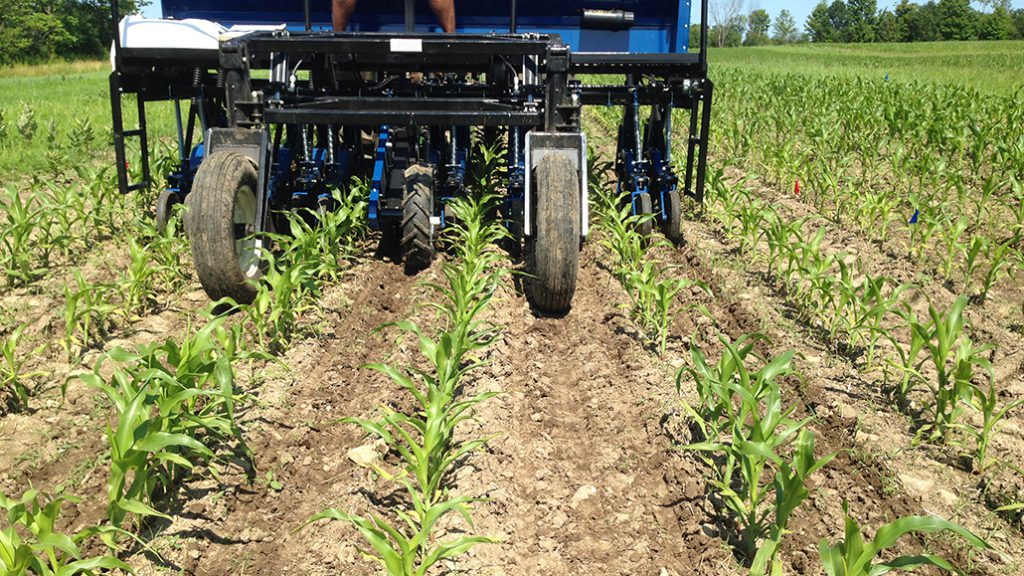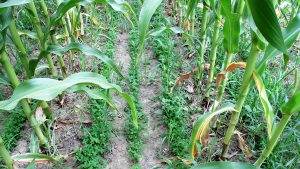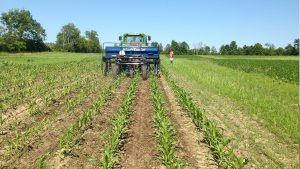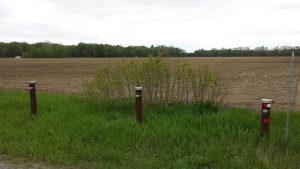Inter-seeding cover crops in corn
ESTABLISHING AGRONOMIC BENEFITS

THERE HAS BEEN considerable research conducted on the use of cover crops after wheat. The relatively short growing season of wheat makes it the ideal crop in the rotation to include cover crops after harvest. There hasn’t however, been much research on cover crops in soybeans or corn in Canada. Not only is corn extremely competitive during the growing season, but it also leaves little room for cover crops to establish after harvest.
Researchers recognize the value of using cover crops to improve and protect soil though, which is why they are working to find a solution to include cover crops in corn. Dr. Mehdi Sharifi, formerly with Trent University and now with Agriculture and Agri-Food Canada (AAFC), is collaborating with Drs. Dave Hooker, Bill Deen, and Laura Van Eerd at the University of Guelph on a three-year project that looks at the feasibility and benefits of inter-seeding cover crops into corn harvested for grain and silage.
The goal of the research is to answer three main agronomic questions and to analyze the resulting soil conditions. The first was to determine if establishment was even possible. Then, they wanted to ensure that the cover crop wouldn’t compete with the corn. The third question addressed the different types of cover crops — red clover, annual ryegrass, and a mixture of the two — and how they affect soil health in the different microclimates and soil conditions in Ontario. To do this, they chose three regions: eastern (Peterborough), central (Elora), and western Ontario (Ridgetown).
The cover crops were planted with a seed drill designed by InterSeeder Technologies, a fairly new company associated with Penn State University, or by broadcasting mixture seed between the rows. Sharifi explains that they were able to plant cover crop seeds between rows up to the 4- to 5-leaf stage of corn with minimal damage.
The experiment looked at cover crop performance in corn harvested for grain in late October versus corn harvested for silage in mid-September, explains Hooker.
“Soybean was planted no-till after a burndown treatment the following year to investigate any differences in soybean performance among the various combinations of corn harvest timings and cover crops,” he says. “Weeds were controlled with safe herbicides before seeding the cover crop.”
THE RESULTS
The first two years of the experiment saw very different climate conditions among the field sites. While 2015 was pretty normal at Elora and Peterborough, it was dry at Ridgetown. In 2016, weather patterns during the 2016 growing season were highly unusual — hot and very dry — across all field sites.

In 2015, all regions saw good establishment and produced between 75 to 2,080 kg dry biomass per hectare (70–1,900 lbs/ac), depending mainly on the field site location. Nitrogen content in the aboveground biomass was five to 78 kg N per hectare (five – 72 lbs N/ac), depending on the field location. In 2016, however, establishment and subsequent growth was even more variable due to a lack of precipitation after cover crop seeding and during the grain-fill period of corn.
In silage and grain corn, the researchers saw differences between each cover crop growth. In November, it was clear that cover crops did better when corn was harvested mid-September for silage rather than grain corn harvested later in October. High-yielding environments for grain corn tend to have denser canopies and were highly competitive for both water and light for the cover crops.
“They basically choked because they didn’t get enough light [and moisture] at the time they needed it,” Sharifi says.
Management practices are also crucial and can affect the results. Overall, drilling the cover crop seeds yielded better results than broadcasting. “We sort of expected that, but we wanted to actually measure and show it,” he says. “Obviously, there’s an additional cost for the drill, but you are going to get better establishment.”
“But the biggest factor for growers is the time it takes to drill the seed compared to broadcast,” notes Hooker. “Some growers have seeders on their equipment for side-dressing N to save a pass over the field.”
With regards to yield and nitrogen uptake, in both years, there was no evidence that corn saw competition from the cover crops. “So the yield of corn did not increase or decrease,” Sharifi explains. “Grain corn yield was the same with cover crops or without cover crops.”

In the following years, there was no impact on soybean yields either. This was the expected result, says Hooker. “We didn’t expect to detect any differences in soybean yield, at least in the short-term, mainly because the biomass produced from the cover crops and any soil health impacts after corn was relatively low,” he clarifies.
Differences in total biomass were noticed between the cover crops. Red clover is a legume and a crop that likes moisture. In a year with enough moisture, red clover will grow well. Annual ryegrass, on the other hand, is more tolerant to drought.
“It seems then, that if you have a mixture of both, you kind of have the best of both worlds,” says Sharifi. “Even if you get into a drought, you have annual ryegrass, so you can produce some biomass.”
In terms of nitrate after corn harvest, in 2015, residual soil nitrate was very low. In 2016, which was very dry, 10 times more nitrogen – in the form of nitrate – was left in the field.
SOIL HEALTH
Beyond agronomics, the researchers also wanted to know what was going on in the soil itself. They wanted to see how inter-seeded cover crops would impact soil health, such as soil total organic matter and particulate organic matter.
“We also measured the nitrate at the end of the season, after harvest,” Sharifi says. “Corn requires quite a bit of nitrogen fertilizer. If nitrogen isn’t used by the plant, then it’s going to stay in the soil in the form of nitrate, which is very soluble and susceptible to leaching in the humid environment of Ontario.”
“We don’t want nitrogen in the soil in the form of nitrate,” he continues. “We prefer if a cover crop takes that up and converts it to organic nitrogen, which will be gradually released in the following season, minimizing the risk of leaching after corn senescence.”
According to Hooker, the main issues are fast and efficient cover crop seeding, and the risk of failed establishment and survival. Drilling is not an option for many because it is time consuming compared to broadcasting. Establishment and survival are highly weather dependent. Furthermore, Hooker says there is very limited potential for biomass production in corn, compared to a cover crop after wheat, for example.
“Cover crop seed can be expensive compared to the return of biomass potential,” he says. “Will it pay?”
Hooker says control of annual ryegrass in the spring can also be a huge problem before soybean. “Also, herbicide options in corn are extremely limited with cover crop blends, especially with the need to practice herbicide resistance management.”
Given the results, both Hooker and Sharifi say inter-seeding cover crops into corn might not be worth it for producers, but the practice may have long-term benefits, which is a hypothesis being explored with a new long-term cover crop experiment at Ridgetown and Elora.
“I don’t have enough data and evidence, and I have not done an economic analysis to see how much it costs and how much they gain,” says Sharifi. “You don’t want to make an investment if you don’t get any returns.”
“The benefits of cover crops in corn are rather limited, given the extreme risk for failed establishment and cover crop growth with full season high-yielding corn crops that compete with light and water during most of the growing season,” Hooker adds. “Nevertheless, some growers like the practice, and they are making it work for them. For most growers, other data from long-term trials in Ontario shows that the biggest return to corn and soybean enterprises, by far, would be to include wheat in the rotation followed by a cover crop.”
This project was funded in part through Growing Forward 2 (GF2), a federal-provincial-territorial initiative. The Agricultural Adaptation Council assists in the delivery of GF2 in Ontario. •

























